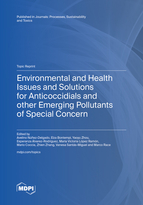Topic Menu
► Topic MenuTopic Editors









Environmental and Health Issues and Solutions for Anticoccidials and other Emerging Pollutants of Special Concern

A printed edition is available here.
Topic Information
Dear Colleagues,
Although previous Topics have considered emerging pollutants, new and crucial data are continuously being generated in this field of research, in terms of both classic and new pollutants. Among them, anticoccidial compounds are gaining increasing attention, and this is also the case for a variety of other substances of emerging concern. This Topic will be open to submissions focused on various environmental elements (soil, water, and air) and those specifically considering living organisms affected by these kinds of contaminants. Both the detection/quantification and removal of these pollutants should be the main objectives in research within this Topic. In addition, articles related to technical, scientific, and/or social aspects affecting this theme will be also considered and well received. The editors of this Topic come from different countries and continents, and their specific fields of research are wide and include a broad variety of subjects, which will facilitate the assessment and finding of appropriate reviewers for each of the submissions: research papers, reviews, short communications, perspectives, etc. The editors expect the published papers to contribute to the establishment solid science and promote new ideas/views that could help to further develop this interesting field.
Prof. Dr. Avelino Núñez-Delgado
Prof. Dr. Elza Bontempi
Prof. Dr. Yaoyu Zhou
Prof. Dr. Esperanza Álvarez-Rodríguez
Prof. Dr. Maria Victoria López Ramón
Dr. Mario Coccia
Dr. Zhien Zhang
Dr. Vanesa Santás-Miguel
Dr. Marco Race
Topic Editors
Keywords
- anticoccidial pollution
- bioadsorbents
- emerging pollutants
- pollution treatment
- soil and water pollution
- air pollution
Participating Journals
| Journal Name | Impact Factor | CiteScore | Launched Year | First Decision (median) | APC |
|---|---|---|---|---|---|

Processes
|
2.8 | 5.5 | 2013 | 16 Days | CHF 2400 |

Sustainability
|
3.3 | 7.7 | 2009 | 19.3 Days | CHF 2400 |

Toxics
|
4.1 | 6.4 | 2013 | 18.1 Days | CHF 2600 |

Preprints.org is a multidisciplinary platform offering a preprint service designed to facilitate the early sharing of your research. It supports and empowers your research journey from the very beginning.
MDPI Topics is collaborating with Preprints.org and has established a direct connection between MDPI journals and the platform. Authors are encouraged to take advantage of this opportunity by posting their preprints at Preprints.org prior to publication:
- Share your research immediately: disseminate your ideas prior to publication and establish priority for your work.
- Safeguard your intellectual contribution: Protect your ideas with a time-stamped preprint that serves as proof of your research timeline.
- Boost visibility and impact: Increase the reach and influence of your research by making it accessible to a global audience.
- Gain early feedback: Receive valuable input and insights from peers before submitting to a journal.
- Ensure broad indexing: Web of Science (Preprint Citation Index), Google Scholar, Crossref, SHARE, PrePubMed, Scilit and Europe PMC.

